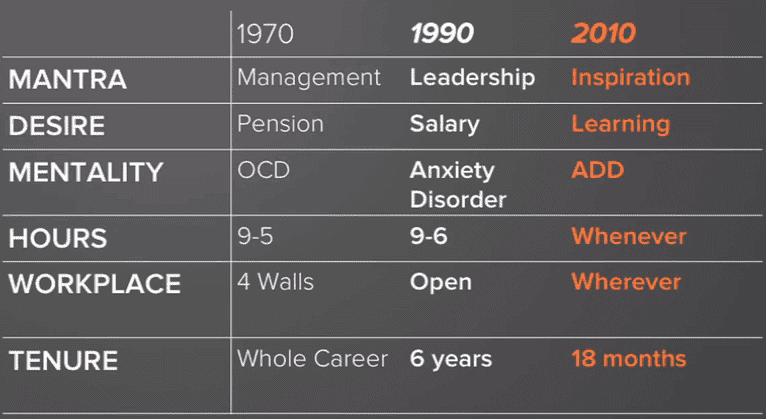What are your career goals? What to do when you don’t know
“Where do you see yourself in 5 years?”“What job would you love to grow into?”Them: * Blank Stare *
What’s a manager to do?!?
In my hundreds of conversations with managers in building Lighthouse, one of the common questions I’ve heard is that you don’t know what to do when your team member doesn’t have a clear answer in mind on their goals. (Ed. Note: If someone is ready for the conversation, this post on having a great goals discussion will help.)
It can happen for good reasons
Not everyone knows who they want to become or what the next step for them is in their career. This can be especially true for people fresh out of college; many are just happy to have *any* job, let alone figuring out what their career should look like.
Especially in high turnover roles like Customer Success/Support it can be important to help people move up or out of the department to avoid them burning out and leaving. Many people also just get in ruts in their careers regardless of age, or haven’t had the time to prioritize thinking about it for any number of personal or professional reasons.
Today, we’ll take a look at 5 approaches you can take so that you can help your team discover their long term goals for growth and career advancement. It’s worth the effort, as it has a major impact on their drive, motivation, and engagement at work (no manager can have too much of that on their team, right?).
5 ways to help your team member answer “What are your career goals?”
1) Use trial and error
If one of your team members is unsure of what they want, but has a few ideas that sound interesting, or a suggestion you make entices them, yet they’re afraid to commit, this is a great option.
To reveal these options to try, ask them what their favorite and least favorite things are on the job. There are likely roles they can grow into that will let them do more of those things they like or build on the skills from doing that. You can also suggest options you know you can help them with to see if anything strikes them.
When this is the case, rather than jump into a deep plan on how they can build a complete skillset to be ready for a new role or promotion, give them an opportunity to dip their proverbial toe in the water. This will make it safer for them to change their mind should they learn more and realize it’s not for them; the last thing you want is them to feel trapped on a path they don’t want.
To try out roles, the easiest thing you can do is introduce them to people you know that already do those jobs. This takes almost no time on your part and potentially matches them with a mentor if they like how a role sounds. When they meet with the person encourage them to ask critical questions like:
- What’s the best part about this job?
- What are the least enjoyable parts of the job?
- What are the critical skills you need to have to succeed in this job?
With those answers, your team member will have a much clearer idea if that career path sounds interesting to them. You can use your one on ones as a time to check in on them as they have a series of these conversations over weeks and months.
2) Lean on their strengths and talents
Everyone has gifts. What are they good at? Reflect on their skills and personality to see what you could suggest as a fit.
- Are they good with people? Maybe a customer facing role would be great for them like being a Product manager or sales rep.
- Are they fast learners and like moving fast? Maybe they should be involved in your skunk works projects and experiments or maybe your growth team.
- Are they more introverted? Perhaps an individual contributor track to become an expert architect or marketing strategist is a better fit.
- Are they super organized and detail-oriented? Then project management, or a role in operations could be interesting.
As a manager, there is huge value in knowing the strengths of your people. In fact, Gallup’s recent “State of the Manager” report showed some startling statistics on why strengths matter:

- “Employees who use their strengths every day are six times more likely to be engaged at work.”
- “When managers focus on employees’ strengths, 61% of workers are engaged and only 1% are actively disengaged“
It takes effort to reflect on your team’s strengths, but it’s clear it’s worth taking the time. Take a break from your immediate work and think about your team members. What do they excel at? Where do they demonstrate potential? What work do they seem most excited to work on? Answers to each of those questions can help reveal a path to suggest to them could be a great career path for them.
A bonus of talking to someone about their strengths is how much they’re likely to appreciate being recognized for things they work hard on and show passion for. Never underestimate the power of telling someone you believe in them or that they could be great at something. As Dale Carnegie says, “Give the other person a fine reputation to live up to.”
3) Give them a mix of small projects
If you get past a few informational introductions to people in roles that may be interesting to them and you’ve talked about strengths and talents, the next way to experiment is to look for small projects they can get involved in.
If the work they are interested in is within the scope of your team, then getting them involved in that area is easy. Just assign it. If it is for another team, talk to that team’s leader and consider small opportunities you can suggest like:
- If they’re interested in marketing, can they work on a guest post for your company blog?
- If they’re interested in new engineering technology, can they pair up with someone in your company’s next hackfest?
- If they’re interested in product, can they sit in on a few customer calls or usability tests?
- If they’re interested in sales, can they contribute in any way to help customers up for renewal or upsell?
- If they’re interested in management, can they try managing a summer intern or get more involved in your hiring process?
Nothing beats getting hands on, so any of these kinds of projects can help them get a feel for what they’re doing. Just remind them that everyone starts out a novice, so the question isn’t if they’re already great at this new opportunity. Instead, the real question is if they’re interested enough in it to want to work hard to become great at it.
4) Consider lateral moves
Sometimes a small change can make a big difference. To keep your team engaged and interested at work, you don’t always need to be rushing them for a promotion; a move laterally within your department can keep things fresh for them. They may not have considered it as an option, so don’t forget to suggest such opportunities.
As Brian Halligan, CEO of HubSpot, describes in his great TEDx talk on “Inbound HR”, especially Millennials are interested in always learning, and changing jobs regularly:

It’s unlikely that someone will be able to be promoted up the ladder every 18 months, so the only way to handle the tenure rate Halligan describes above is to also offer lateral moves to team members.
I have a friend who worked over 5 years at HubSpot and during that time moved around from customer support to ops to IT, so this is not just talk by Halligan. If they can do it, so can you.
5) If all else fails: Use FOMO
If you still can’t get anything out of them, the best thing to do may be nothing. Leave the door open to revisit their goals any time in the future, but don’t waste your time on someone that won’t engage. Too many managers get sucked into investing most of their time in under-performers when they could use the 80-20 rule to see they’d get more out of an investment in their best people.
Think about it: better motivating someone that can be a major contributor can significantly improve your overall team output significantly more than getting just a little bit more out of an under-performer that requires tons of coaxing and effort by you. In the end, it’s their career and they have to want it.
So for those that aren’t showing any interest in talking about their goals, let FOMO (the Fear Of Missing Out) light a fire; when they see their colleagues getting raises and promotions as others add skills and grow, they might just want a chance too. When they feel FOMO, they’ll be ready to have a discussion about their career opportunities and more importantly, be willing to put in the work to get there.
Don’t be afraid to let go
Sometimes your team will have career goals that take them away from working for you. It takes a brave manager to be willing to support them anyways, but if you do, you will be paid back many times over.
A personal example: In a past business I ran, I had a star team member doing business development and sales for us. She was crucial to our success. One day she told me she wanted to become a product manager.
Rather than shut her down on the idea, I offered to help teach her the skills to become a product manager and introduced her to others that could mentor her. Not only did she learn those skills so she’s a product manager today, but for the next year working with us, she did even better sales and BD work. All because I spent a bucks on books, an hour a month teaching her PM skills, and made a few intros. (Read more about this story here)
Doing this for my former team member wasn’t just a short term payoff until she left. She helped recruit her replacement, put in a good word about working for me, and is someone I expect I will be able to work with again in the future. All because I showed I genuinely wanted to help her even when there was nothing in it for me.
If you’re at a bigger company you can get all those benefits, plus score points with another manager who may be able to hire them for their desired new role. Everyone wins when you can hire internally and already know they’re a culture fit, work hard, etc. One day karma may pay you back with a similar transfer, especially when others hear how awesome you are to work for.
—
Don’t force a career path on someone just because you need to fill a role. That’s a fast way to disengage a team member. It does you no good to try to force a job on someone that is not excited about it and it certainly won’t motivate them to learn the skills to succeed in that role.
On the other hand, helping someone discover their career path is a sure-fire way to get them motivated on the job. It’s also a great way to better connect with and understand them. It takes hard work to be a good manager, but investments like helping people answer the question what their career goals are puts you on the path to being a great leader.

